Q&A – Ask Neil: August 14, 2025
(Please read these instructions carefully.)
Before you post your question, please look at recent issues to see if someone else has already asked it. You might find your answer there.
How to submit your question…
(Note: You may need to allow a pop-up window to come up in order to get the link for sending your photo(s). If you have already submitted your question and didn’t see the pop-up window, please click here.)
• Click the link provided below to post your question. After you submit your question, a new window will pop up giving you the address to which you can e-mail a SHARP, HIGH-RESOLUTION PHOTO to accompany your question. Please DO NOT SEND THUMBNAIL PHOTOS in case I need to zoom in to see things.
• Click here to post your question.
• Please ONLY POST YOUR QUESTION ONE TIME. We can only accept a set number of questions each week, and when we get duplicates it costs other people their chances.
• One question per reader, please.
• Please use this only for posting questions – not for standard emails.
• Watch for your answer in the following week’s e-gardens.
• I choose those of greatest general interest. For example, plant IDs seldom make the cut.
• I must have your first name or initials.
• I must have your city or county. (Texas is a very large state.)
Important favor: I’ve been covered up so far this year with questions about live oaks losing chunks of bark. Rather than continuing to answer the same questions weekly, I’d ask that you look back to previous issues. You’ll find several replies that I’ve posted. Thanks!
QUESTION 1
IS PHYTOPHTHORA A PROBLEM WITH PLANTS LOCALLY, AND HOW DO I DEAL WITH IT?
Question: I’ve been hearing about a problem called Phytophthora that is supposedly killing a lot of plants in my area right now. The garden center I went to told me it’s because of too much rain/moisture. Is that true, and if so, how can I prevent it? Joyce C., Bedford.
Answer: Phytophthora is one of a group of diseases known as water mold funguses. They are spread by splashing water, whether from rainfall or irrigation. One of the common examples is the stem disease that kills so many vinca annual flowers. Their stems will look like they have been touched by a red-hot knife on one side. The side branches and leaves on that side will wilt, then the entire plant will succumb. Damping off of seedling plants is another example where tender young seedlings suddenly lose stem strength and topple over. Pythium is the fungus involved in that problem.
It’s difficult to cure the various water mold funguses. You always want to provide the best possible drainage. In the case of the vincas, go for the Cora XDR Series, standing for extra-disease-resistant. It’s also best to plant in raised beds, also to delay planting until most of the heavy spring rains have probably finished.
QUESTION 2
WHAT CAN I DO FOR MOLES?
Question: Moles are tearing up my ditch bank and killing my bermudagrass. What is the best way to eliminate them? Linda K., Greenville.
Answer: They certainly can do a lot of damage in a hurry. I have that answer in the FAQ pages of my website. Without trying to look lazy, I’m just going to copy and paste it here:
“Moles have hairless, pointed snouts extending nearly 1/2-inch in front of their mouth opening. Their small eyes and the opening of their ear canals are concealed in fur, and there are no external ears. Moles are insectivores, related to bats. Moles are generally found in cool, moist and shaded soils that are populated by earthworms and grub worms. Moles leave volcano-shaped hills that are often made up of clods of soil. Moles are best controlled using traps that are implanted into depressed portions of the surface tunnels. As the moles push up to re-open their tunnels, the traps are triggered.”
QUESTION 3
WHY ARE OUR VITEX TREES SO PALE THIS YEAR?
Question: We have two 10-year-old vitex trees. They have bloomed beautifully every year, but this year the flowers have been very pale – almost no color. What happened? Maxine K., Tomball.
Answer: Others have reported the same thing, and I’ve noticed it with vitex in the DFW area as well. Scale of 1-10, I would have given them a 2 or 3 for intensity of blue this year. Usually that points to cool, cloudy weather as the flower spikes are forming, and that certainly was the case this year. It will also happen when we go from favorable moist weather with tolerable cloudiness directly into hot, sunny conditions. That causes them to bleach out, and there was some of that, too. My wife and I were in Houston in early July, and I noticed what you were saying. My only suggestion is that you wait it out. Next year should be better.
QUESTION 4
WHY ARE LEAVES YELLOWING ON MY NEW YAUPON HOLLY?
Question: We planted a yaupon holly in June. I have kept it watered, but some of the leaves are yellowing and dropping. Why would that be happening? Also why are there brown leaves on my cleyera and azalea? Anita V., Granbury.
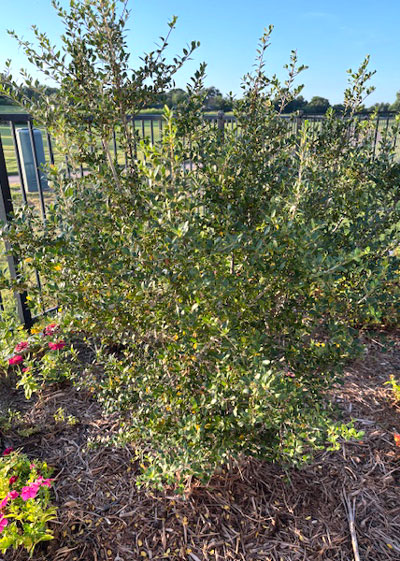
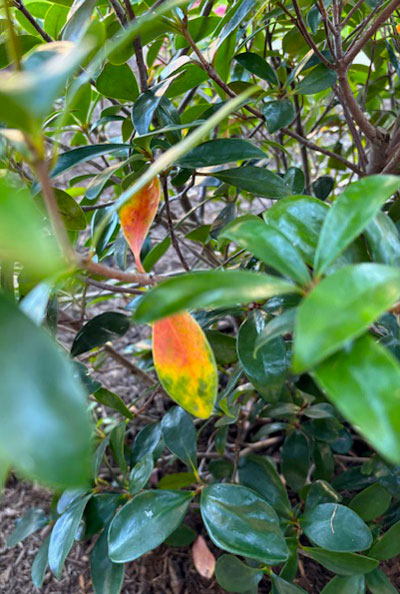
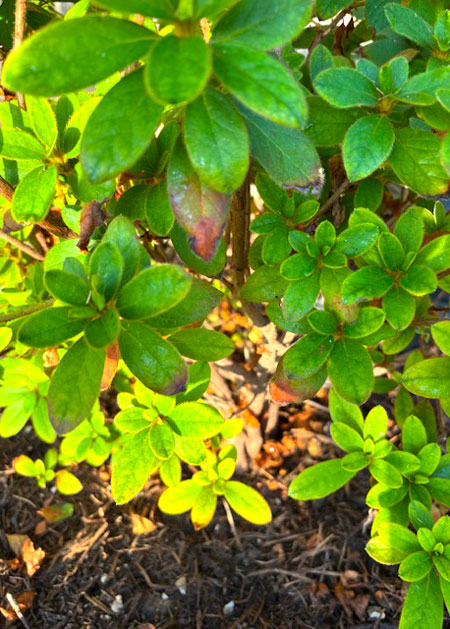
Images are clickable for larger views.
Answer: The yaupon probably just got marginally dry at some point. Those are older leaves, and it’s just shedding them to get rid of some of the “responsibility.” Be very careful with your watering the balance of this summer. Yaupons are native to very moist areas. Water every couple of days for the next 2 or 3 years. Do so with a garden hose and a water bubbler or water breaker, not with sprinklers or drip irrigation.
I think your cleyera is just shedding a couple of old leaves – no big deal there. Again, just don’t let it dry out. The azalea looks like it’s already running out of soluble iron. Add an iron product with sulfur soil acidifier included in it. When we plant azaleas west of the East Texas Piney Woods they require highly amended soils with almost pure organic matter (peat moss and shredded bark mulch). This may be an ongoing affair for you.
QUESTION 5
WHY WOULD MY ROSE-OF-SHARON DIE WITHIN JUST A FEW DAYS?
Question: What is wrong with a rose-of-Sharon whose leaves yellow and drop within just a matter of days? Marilyn R., Granbury.
Answer: Cotton root rot, the insidious soil-borne fungus that lies dormant in the soil for 10 or 15 years, then suddenly rises up to kill susceptible plants. Somewhere around 80 percent of the plant types that we grow are susceptible, most notably members of the cotton family (hence the name of the disease). Roses-of-Sharon (althaeas) are in that family. You need to replant with a resistant or immune type of plant. The best choices include hollies, nandinas, junipers, crape myrtles, and oaks.
QUESTION 6
WHAT IS CAUSING THE BROWN SPOTS IN MY BERMUDAGRASS?
Question: I have lots of brown spots in my bermuda lawn. Additional watering does not seem to help. I don’t know if chinch bugs bother bermuda. I have not been able to see any of them. What else might it be?
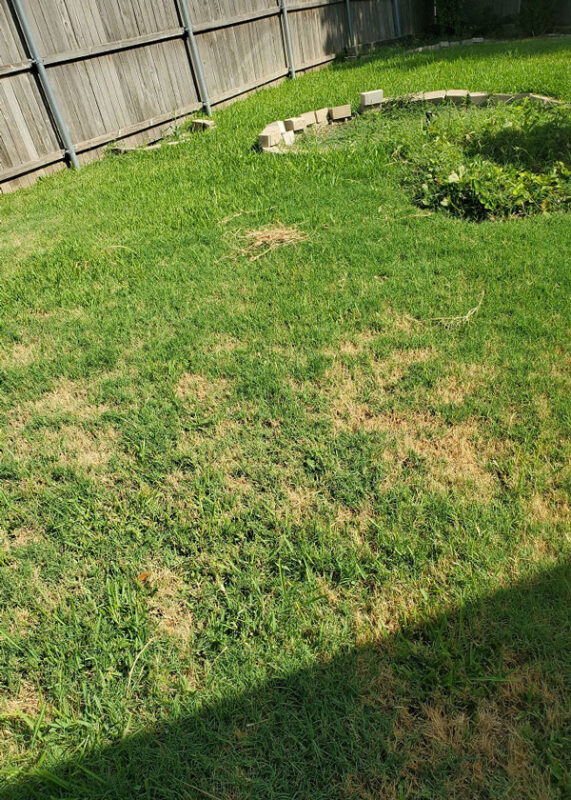
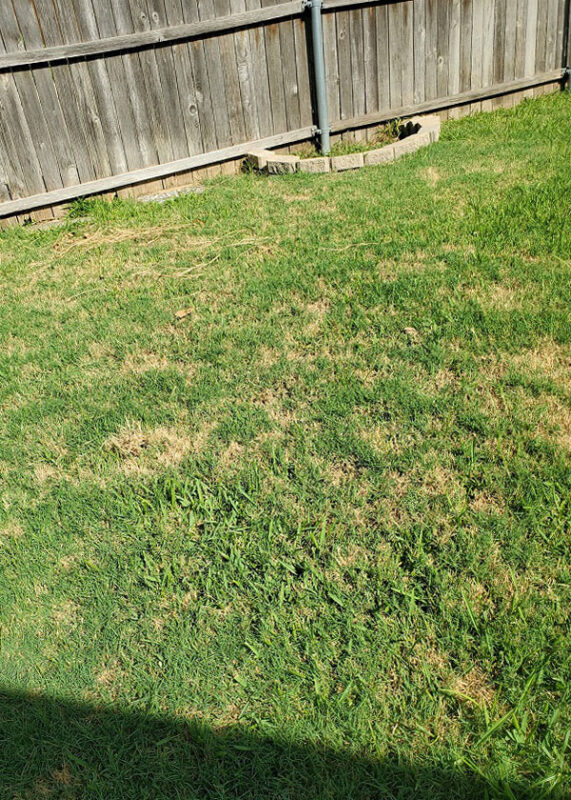
Images clickable for larger views.
Answer: I’m guessing it’s probably Pythium blight, another one of the water mold funguses similar to the ones I mentioned earlier. Bermudagrass turf often develops random streaking during the summer from a disease of excesses called southern blight or cottony blight, and you’ll usually see it in low, wet areas like the lawn I photographed in Allen several years back.
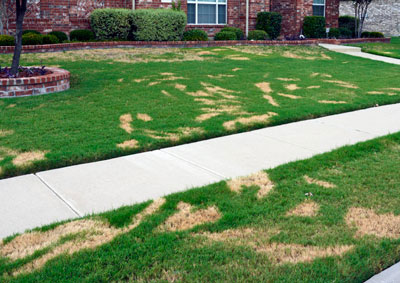
Do not go out of your way to provide these areas extra water or fertilizer – just what you give the rest of your lawn. The turf in the photo from Allen bounced back quickly once things dried out. I have to admit I was surprised.
